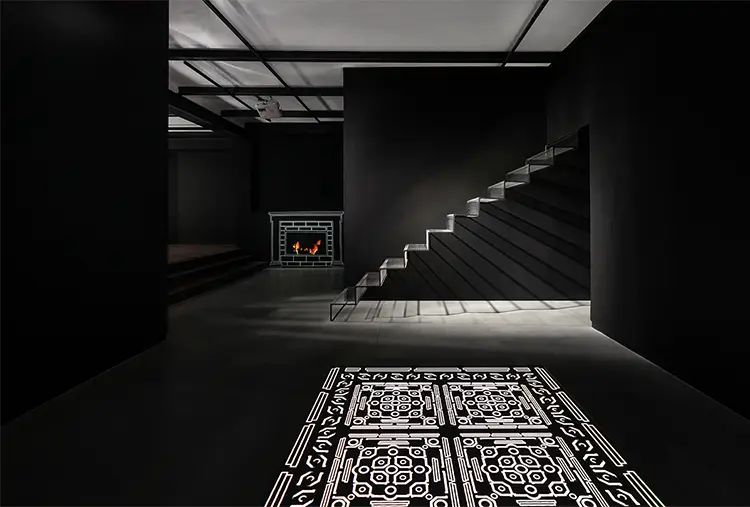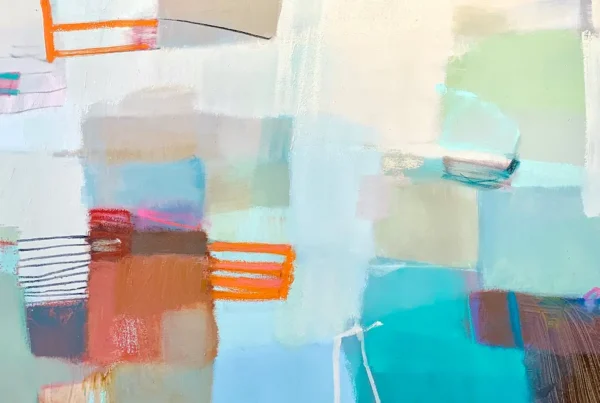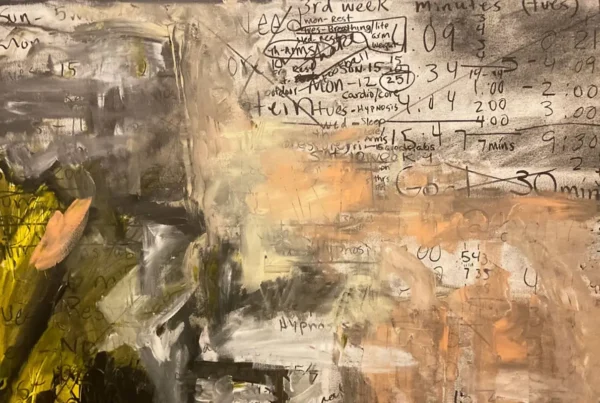“The fragile physical house, laden with social, political, and cultural associations, serves as a metaphor for life, the psyche, and both personal and collective identity.”
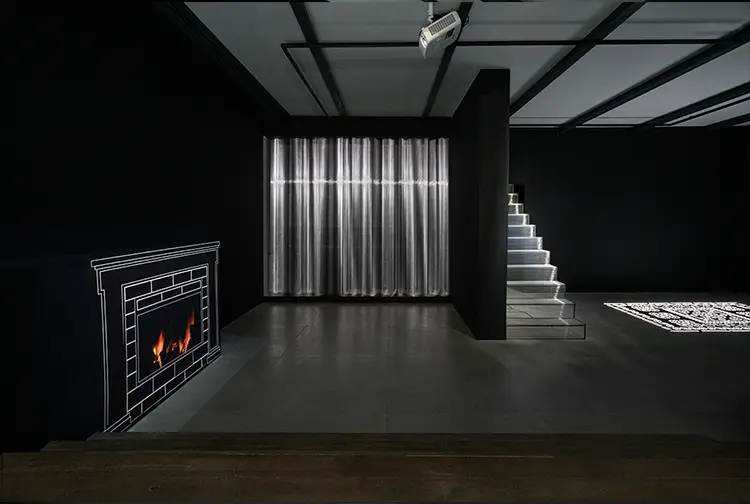
“The Pulsating Room,” 2023
Installation view from the exhibition
Credit: Liat Elbling
Tracing Shadows: The House as an Emotional Blueprint
Emerging as a compelling voice in contemporary multidisciplinary art, Tal Amitai-Lavi (Instagram: @tal_amitai_lavi) has cultivated a body of work that deftly intertwines drawing, sculpture, installation, painting, and video. Her artistic identity is deeply informed by a dual trajectory of rigorous academic training and extensive pedagogical involvement, alongside a dynamic exhibition history spanning major museums and galleries. Amitai-Lavi’s works live at the intersection of intimate narrative and collective consciousness, embedding tactile materiality with philosophical depth. Her fascination with material transformation and conceptual nuance places her among a generation of artists who do not merely depict ideas, but build them—sometimes quite literally.
A recurring motif in Amitai-Lavi’s practice is the image of the house, treated not simply as architecture but as a vessel of memory, instability, and paradox. Her pieces often repurpose fragments of damaged or destroyed buildings—whether impacted by natural disasters or warfare—as starting points for meticulous renderings and installations. She recreates these fractured homes using a painstaking process of pasting black sewing threads onto transparent plexiglass, allowing imperfections and frayed threads to remain visible. These visual choices reflect not only loss and vulnerability but the fragile persistence of memory. The work doesn’t shout; it murmurs stories through threads, shadows, and translucence, constructing a visual syntax that is both restrained and profoundly evocative.
This preoccupation with the ephemeral and the architectural is rooted in formative personal experiences. As the daughter of a building contractor and architect, Amitai-Lavi was immersed in the skeletal landscapes of construction sites during her childhood. Raw concrete, unfinished staircases, and improvised structural forms became part of her visual lexicon. Parallel to this architectural exposure were shared fishing excursions with her father, where transparent lines stretched across the horizon became metaphors for connection. These memories—tactile, visual, and emotional—surface again and again in her work, manifesting as suspended staircases or thread-based illusions of domesticity, charged with both intimacy and unease.
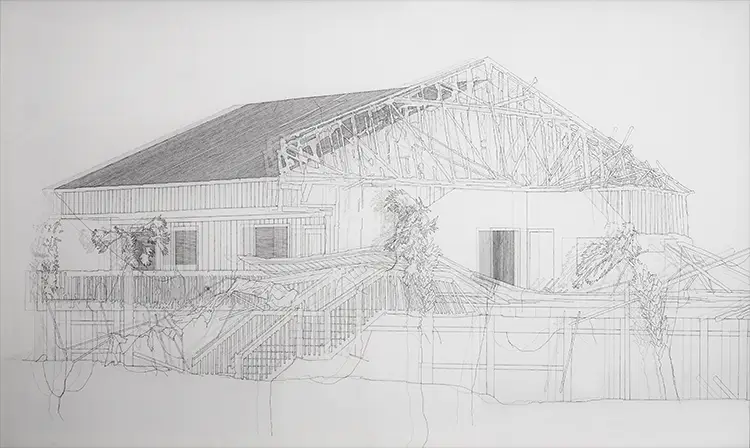
“Katrina“, 2007
Threads on Perspex, light 131 x 216 x 8
Tal Amitai-Lavi: Material Poetics and the Language of Fragility
Amitai-Lavi’s artistic language is deeply rooted in a nuanced and often poetic manipulation of humble materials. She favors everyday substances—sewing threads, nylon strings, kinetic sand, baking soda powder, suction cups—and transforms them into intricate visual metaphors. Her work resists categorization, flowing fluidly between artistic disciplines while challenging conventional hierarchies between traditional and nontraditional media. What defines her creations is not just innovation in technique, but a philosophical inquiry into the meaning and materiality of what we often overlook. Through this lens, she creates a space where fragility is not only aesthetic but conceptual.
At the heart of Amitai-Lavi’s approach is an acute sensitivity to the relationship between form and meaning. Rather than allowing the medium to merely serve the image, she allows the material itself to become the image—imbued with narrative weight and philosophical tension. This is especially evident in her large-scale installations, where thousands of transparent nylon threads sculpt illusory domestic environments: doorways that lead nowhere, staircases that ascend into absence, and curtains that shimmer without substance. Her works destabilize the viewer’s spatial and emotional bearings, demanding a reconsideration of what it means to inhabit or remember a “home.”
Her installation environments do more than mimic domestic architecture—they subvert it. By using transparent lines and calculated lighting, she invites viewers into spaces that feel simultaneously present and absent. These are not mere reconstructions of place, but reflections on instability, impermanence, and longing. Whether referencing homes shattered by disaster or abstracted elements of everyday life, Amitai-Lavi turns spatial memory into a tactile experience. Through her precise use of fragile materials, she challenges assumptions about permanence, forcing a confrontation with both personal vulnerability and collective displacement.
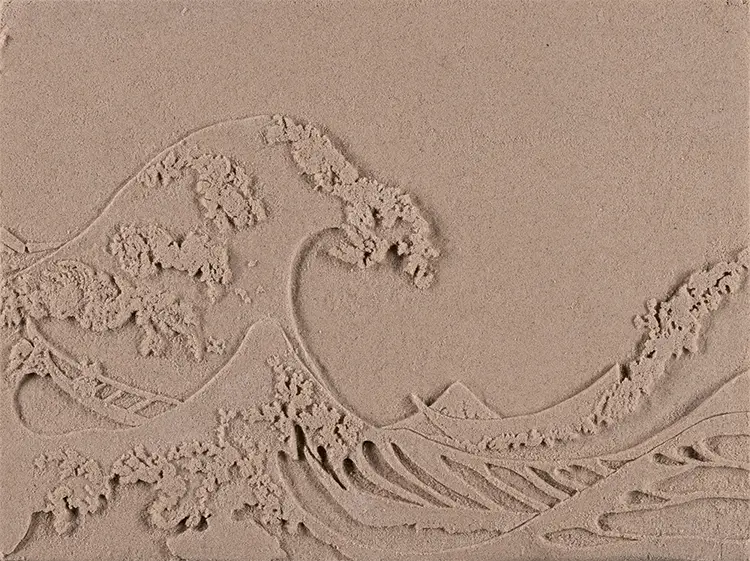
“Homage to Hokusai“, 2019
Kinetic sand, wood drawer, 32 x 40 x 5
The Pulsating Room: Animating Absence and Illusion
Among her most significant recent works, The Pulsating Room (2023) stands as a monumental expression of Amitai-Lavi’s conceptual and material concerns. Conceived as a three-room apartment installation, the work comprises five domestic elements: a curtain, a fireplace, a carpet, a staircase, and windows. Each is constructed using projections and stretched nylon threads, challenging the viewer’s perceptions of space and structure. The installation opens with a projected rug animation, slowly assembling and disassembling ornamental patterns in an endless visual rhythm. This entrancing loop sets the tone for the exhibition—a meditation on temporality and transformation embedded in the language of home.
The next phase of the work introduces a staircase constructed from nylon threads stretched across a barely visible metal frame. The piece levitates against a black wall, its delicacy underscoring its uselessness—it cannot be climbed, and it leads nowhere. In the adjacent space, a fireplace appears as a video animation of white lines tracing brick patterns on a dark background. Embers glow, but no heat is emitted. The illusion is complete: warmth is implied but unattainable. A curtain composed of vertical nylon threads rises from floor to ceiling, shifting with projected beams of light to mimic a phantom wind. These elements, working in concert, create a space that feels familiar yet eerily unreachable.
In the final room, transparency dominates. Instead of iron-framed windows, two ethereal openings composed entirely of threads disrupt the boundary between interior and exterior. Rather than offering a view of the street, they redirect the gaze inward. A video projection ripples across the floor in spiraling rhythms, mimicking the act of breathing. This subtle, cyclical movement evokes the quiet mechanics of life itself—fragile, repetitive, and vital. Collectively, The Pulsating Room does not merely depict domesticity; it questions it, dismantles it, and rebuilds it in spectral form. The viewer is left suspended, not unlike the installation itself, between familiarity and estrangement.
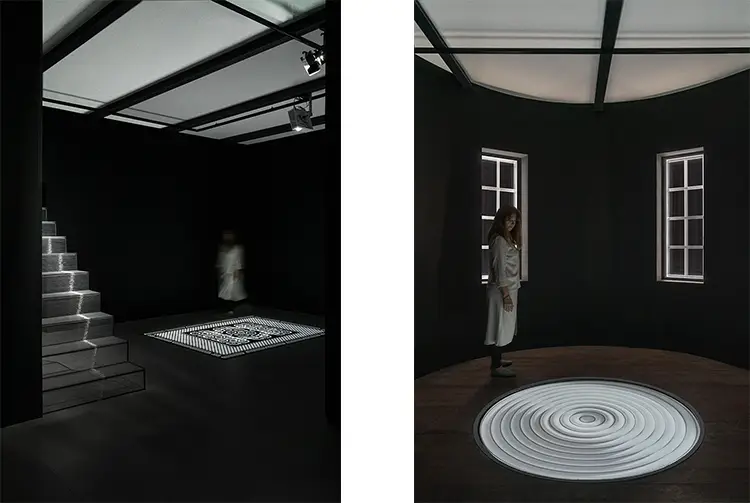
“The Pulsating Room,” 2023
Installation view from the exhibition
Credit: Liat Elbling
Tal Amitai-Lavi: Architectures Yet to Come
Looking ahead, Amitai-Lavi continues to push the boundaries of material-based installation with her upcoming exhibition, Choreography of a Line. Envisioned as a sound and video installation, the project represents a bold evolution in her practice, replacing nylon threads with animated projections. Collaborating with an animator and a musician, Amitai-Lavi orchestrates a dialogue between line and sound, drawing ephemeral architectural forms only to dissolve them in rhythmic cycles. The animation draws white lines on the darkened walls, synchronized with an original soundscape that echoes the very act of drawing. This interplay between the visual and the auditory aims to create an immersive experience where structure and sensation collapse into one another.
This project emerges from a long-standing desire to experiment with sound as an integral medium. Over several years, Amitai-Lavi has envisioned an environment where threads are no longer physical but made of light, and where architectural forms appear and vanish with the stroke of a digital brush. The animations are now ready, and she anticipates the upcoming gallery opening where this vision will finally materialize. The installation builds on themes familiar in her oeuvre—impermanence, illusion, memory—but expands them into a synesthetic dimension, inviting viewers not only to see and feel, but to hear the unraveling of space.
Amitai-Lavi’s ongoing artistic evolution is also deeply shaped by her role as an educator. Her position as a senior lecturer in art has allowed her to influence the next generation of artists, sharing her insights into the significance of materiality, the potential of interdisciplinary work, and the necessity of conceptual rigor. This educational engagement reinforces her commitment to expanding the vocabulary of contemporary art. Whether she is working with thread, video, or sound, Amitai-Lavi’s practice remains rooted in a restless inquiry into what art can reveal—about the structures we live in, the memories we hold, and the illusions we construct to make sense of both.
